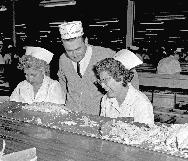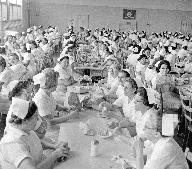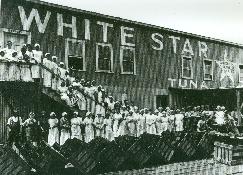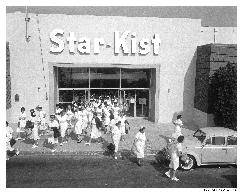RESOURCES
Essay
Placing the Cannery Women of the Los Angeles Harbor Area into
California Regional History: Inclusive Methodologies and the World
Wide Web
|
Through the 1940s and 1950s, in San Pedro, California, at the
southernmost tip of Los Angeles County, hundreds of women went to work
each day in the tuna canneries across the main channel on Terminal
Island. Central to the canning process, women worked on the canning
room floor as cleaners, sorters, packers, and inspectors. Some became
supervisors, quality control experts, and office support staff. Women
were permanent and integral participants in the rise and success of the
Los Angeles Harbor commercial canning industry. However, it is only
recently that their experience has been acknowledged has a historically
significant.
The study of the history of the American West
has recently made a great shift toward inclusivity. This shift has
given historians new means to see groups like the Terminal Island
cannery women as significant in both the theoretical structural and in
the physical development of the region. In the mid-1980s, those
actively involved in the historiography of the American West finally
chose to put Frederick Jackson Turner’s Frontier Thesis to rest. The
West was no longer an unfurling Eden of land and resources, waiting for
|
 |
| Having a laugh at a quality control inspection station, Star-Kist, 1963. ~ courtesy Port of Los Angeles |
|
|
the westering advance and constructive hand of
the Euro-American Christian man, but a place already rich with native
history and cultural convergences. As historian Patricia Nelson
Limerick recognized, the West was “as many complicated environments
occupied by natives who considered their homelands to be the center not
the edge.” 1
With a lens of pluralism as the new methodology, recent scholarship has
pressed even further. Gender scholar and historian Susan Armitage, in
her emphasis of daily experience as historically relevant, reveals
women’s active presence in the development of the region. Too often,
she finds, women are exceptions in a male-driven trajectory of
history. To counter this, she draws attention to the dailyness of the
western people’s experience. Her perspective shows regional
development as less an explosion of events – elections, mining
discoveries, battles – and more a hum of rising and getting work,
speaking with neighbors, housekeeping, and community activities.2
Historian Elliott Barkan, concurrently, demonstrates the centrality of
specifically twentieth-century immigration and westward migration to
the economic and cultural growth of the West. His analysis shows the
West to be a place shaped by a constant influx of immigrant labor
competing for work and space. At the same time immigrant workforces
provided the energy to build national infrastructures, mine raw
materials, plant and harvest food, different ethnic groups settled in
particular areas where they formed self-help and fraternal cultural
centers, schools, and churches. In this way, western communities,
Barkan reveals, are all built through immigrant or ethnic experience.
|
 |
| Lunchroom scene, Star-Kist Plant 4, nd. c. 1963. ~ courtesy Port of Los Angeles |
|
|
Armitage and Barkan and the recent shifts in historical methodology
allow the cannery employees’ experiences to become part of the
historiography of Los Angeles Harbor and the region as a whole. As
historian Donald Worster recognized, “a region emerges as people try to
make a living from a particular part of the earth, as they adapt
themselves to its limits and possibilities.”3 Not only does this apply
to the immigrant fishermen following the fish into southern California
waters or to those who became recognized entrepreneurs but also to the
women who worked and in some circumstances, made careers in the fish
canneries.
To acknowledge women’s cannery experience is only the beginning.
Chronicling it and placing it meaningfully into local history and into
the story of regional development requires active and creative
historianship. While sources at mid-century note the development of
the canneries as entrepreneurial accomplishments, there is a discreet
lack of cannery labor.
|
Promotional pamphlets of the era often tell the cannery story from the
administrative level or from the perspective of the fishermen (and
sometimes, even, from the point of view of the fish). One StarKist
booklet begins the story, “When tuna arrive at a typical U.S. packing
center, they find waiting to accommodate them one of the most highly
perfected food processing establishments in the world . . . here the
tuna are cooked and canned.”4 Another Star-Kist informational booklet
praises the company’s founder, “the history of American business
enterprise is rich in accounts of self-made men, enterprising men of
ideas and courage who achieved a high measure of business success.
Such a man was M.J. Bogdanovich.”5
In order to fill this
interpretive gap, historians ask who was doing the labor. Once this
question is posed, the experience between the harvested product and the
culminating executive success becomes central to the story. The
majority of people in this space were wage earning, unionized women who
cleaned, inspected, and packed tuna and still more women who worked in
clerical, communications, and office management.
|
Susan Armitage points out that it is easy to write about unique individuals whose accomplishments are numerable and well documented. In this way history is inappropriately distilled to point persons and events. Instead, she urges the that history is more truly the “sum total of innumerable small actions and reactions by ordinary people as they come in contact with other people who may seem similar or very different from themselves.”6
From this more authentic vantage point the efforts of women inside the cannery and their daily experiences moving through the community reveal an unexcavated layer of local history and regional development. New oral histories play a key part in this reinterpretation of cannery work. When Goldeen Kaloper remembers quality control issues involving mercury; when Tina Ursich discusses investing her cannery wages, as a single woman, in local property; and when Mary Oreb discusses packing tuna for the army and for kosher distributors or training Star-Kist employees in American Samoa, not only do their cannery experience come to the fore, but their connections to broader issues become evident as well.
|
 |
| Van Camp Cannery's White Star label crew, nd. c. mid-1930s. ~ San Pedro Bay Historical Society |
|
|
 |
| Heading home from Star-Kist Plant 4, 1963. ~ courtesy Port of Los Angeles. |
|
| It can be overwhelming to find and incorporate the relevance of an
omitted group into local and regional historical understanding. Public
exhibits that showcase once- marginalized populations are means to
normalizing a more faceted history. This on-line exhibit featuring the
women of the Terminal Island canneries at mid-twentieth century is a
piece of the process. By centralizing the presence and influence of
immigrant- and first generation-American women cannery employees, it is
meant to add depth to the local and regional story of western economic
development.
-Taran Schindler
California State University Fullerton
Public History, Masters Candidate
December 2008
|
~~~
1 Patricia Nelson Limerick, The Legacy of Conquest, (New York: W.W. Norton & Co, 1987), 26.
2 Susan H. Armitage, “From the Inside Out: Rewriting Regional History,” Frontiers: A Journal of Women Studies 22, no. 3 (2001): 32-47.
3 Donald Worster, “New West, True West: Interpreting the Region’s History,” Western Historical Quarterly 18:2 (1987): 149.
4 “The U.S. Tuna Industry,” A Report by the Editors of Good Packaging, complimentary pamphlet from Star-Kist Foods, Inc., Terminal Island, California, (no date): 15.
5 The Star-Kist Story, company pamphlet, Starkist Foods, Inc., H.J. Heinz Co. (1962): 3.
6 Susan H. Armitage, “From the Inside Out: Rewriting Regional History,” Frontiers: A Journal of Women Studies 22, no. 3 (2001): 36.
|
|
|